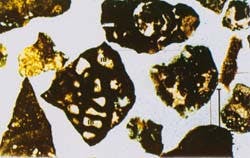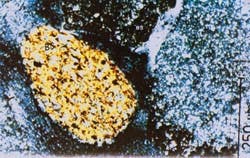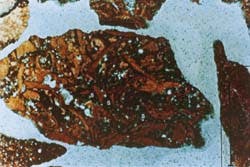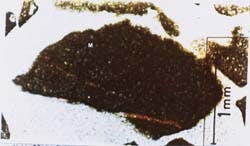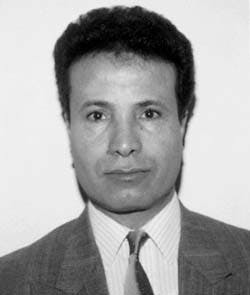Ali Said Trabelsi
David K. Davies & Associates Inc.
Houston
A relatively deep Cambro-Ordovician Ellenburger gas prospect exists around JM gas field in Crockett County and Will-O gas field in Val Verde County of southern West Texas (Fig. 1) (31263 bytes).
These fields, discovered in 1965 and 1971, respectively, produce nonassociated gas from Ellenburger carbonates. Average porosity of the reservoir rocks is 4%, and permeability ranges between 0.1-10.0 md.
The original gas-water contact is at about 12,100 ft and 14,000 ft, respectively, with both fields having depletion gas drive mechanisms. The produced gas contains about 22% CO2.
Significant anticlines exist around these fields. They are mapped at the top of Devonian rocks (Fig. 2) (90677 bytes) and occur on several fault blocks. These structure features can reflect deeper Ellenburger anticlinal traps, and seismic data should verify their existence.
They are bounded by several major faults trending west-northwest to southeast. These faults are very important in that their planes probably acted as migration pathways for hydrocarbons in the past and provide seals for accumulation at present.
On approved spacing of 640 acres/well, several new Ellenburger wells that are capable of producing commercial gas can be drilled on these structures. Significant opportunities also exist for deepening wells that did not penetrate Ellenburger rocks.
Other rock units such as Upper Pennsylvanian Strawn limestone, Devonian chert, and Simpson carbonates that are productive in other parts of the Permian Basin have poor reservoir quality in this area. This article gives a brief assessment of their potential.
STRAWN LIMESTONE
This rock has relatively low porosity and permeability. Approximately 4% porosity is preserved in the grainstones and 2% in the wackestone lithofacies. Intrabiotic and intergranular pores in the grainstones are largely occluded by the precipitation of sparry calcite cement (Fig 3).
Moldic porosity in the wackestones is cemented with pore filling calcite, and the lime mud matrix of this rock is pervasively recrystallized. Recrystallization destroyed the initial microporosity and the permeability of the rock matrix. Recrystallization resulted from meteoric water diagenesis during prolonged episodes of subaerial exposure of the Strawn limestone. Because of its low porosity and permeability, this rock constitutes a poor reservoir for hydrocarbon accumulation, regardless of trapping conditions.
DEVONIAN CHERT
The low reservoir quality of this chert, in addition to the relatively organically lean overlying Woodford shale as a potential source rock, does not make this rock a good target for hydrocarbon accumulation.
Measured total organic carbon (TOC) for the Woodford shale from the Shell 1 and 2 Mitchell wells ranges between 0.35 and 0.61 wt %, respectively. These TOC values are low for the usually organic rich Woodford shale. In many parts of the Permian Basin TOC for this shale ranges up to 21 wt %.1
The Woodford shale in this area underwent intensive silicification (Fig. 4). Silica (in the form of microquartz) replaced and cemented clay minerals and organic matter.
Examples of silicified palynomorphs were detected in the Woodford shale from the Mobil 1 Kruger well. These palynomorphs were not compacted, and they retained their original spherical shapes because their interiors were completely filled by silica. This petrographic observation suggests that silicification occurred as an early diagenetic event after deposition and before compaction. Early silicification may have destroyed a significant portion of the organic matter and may explain the low TOC in this shale.
SIMPSON GROUP
Simpson dolostone units consist of very fine crystalline dolomite that exhibits no or very little porosity and permeability. This dolostone was possibly subjected to more than one episode of dolomitization as evidenced by the precipitation of appreciable amounts of dolomite cement epitaxially and in the intercrystalline pores. Dolomite cement destroyed most of the initial porosity and permeability.
In addition to the poor reservoir quality of the Simpson rocks, the Simpson shale units constitute poor source rocks. The highest TOC is about 0.3 wt %.
ELLENBURGER CARBONATES
The Ellenburger rocks in this prospect contain some scattered intervals of solution collapse breccia. Breccia consist of subangular collapse dolomite clasts and internal sediments filling fractures.
Solution-collapse breccia zones are frequently associated with major porous zones.2 However, in this prospect they do not appear to contribute much to the porosity and permeability of the Ellenburger rocks. The fractures and vugs in this breccia are syndepositional and are largely filled with dolomite cement, carbonate clasts, and fine internal sediments.
Solution-collapse breccia develops after lithification by the dissolution of carbonate or possibly evaporate rocks.2 In this study breccias are probably the result of subaerial exposure of the Ellenburger rocks and their subsequent erosion under karst-like conditions. Loucks et al.2 indicated that during Ellenburger sedimentation there were many periods of subaerial exposure that resulted in the formation of diagenetic terrains represented by poorly formed soil horizons and solution-collapse breccias.
The Ellenburger dolostone reservoirs in this prospect have been altered by abundant tectonically induced fractures and microfractures scattered throughout the section. Large fractures are completely to partially cemented with calcite and dolomite. Very thin fractures and microfractures are open or partly filled with calcite, dolomite, or dark-colored material that may represent organic matter or dead hydrocarbons. Dual crosscutting fracture systems are detected in many Ellenburger dolomite intervals (Fig. 6). Their cross-cutting relationships may suggest that several fracturing episodes have affected the Ellenburger carbonates. These fracturing events could be associated with Pennsylvanian tectonic activity that resulted in the formation of the Delaware, Midland, and Val Verde basins and the Central Basin platform.3 Large field-bounding faults and small, closely spaced Ellenburger open fractures formed during this activity.3
Ellenburger dolostone intervals that contain abundant partly open microfractures constitute good reservoirs and can have up to 8% porosity. Ellenburger rocks produce gas from as low as 4% porosity. Fractured dolostone intervals are well developed in blocks Q3 and Q6 of the prospect area. Open microfractures that probably act as connecting networks for other more isolated pores provide the large portion of the overall effective porosity and permeability.
CONCLUSIONS
Significant anticlines mapped at the top of Devonian rocks can reflect deeper Ellenburger traps in the prospect area. Several new potentially productive Ellenburger wells can be drilled on these structures.
Ellenburger rocks in the general area have adequate to good reservoir quality. Pay zones have 4-8% porosity. Microfractures and intercrystalline porosity constitute the predominant type of pores.
Other rocks units, such as the Strawn limestone, Devonian chert, and Simpson rocks do not appear to have potential for hydrocarbon accumulation in this area.
ACKNOWLEDGMENTS
I am grateful to Dr. David K. Davies for his help and thank Kenny McGee for reading the manuscript.
REFERENCES
- Trabelsi, A.S., Depositional environment of the Woodford shale (Upper Devonian) in the Permian Basin, Geological Society of America, south-central section, Stillwater, Okla., abstracts with programs, Vol. 23, No. 4, 1990, p. 34.
- Loucks, R.G., and Anderson, J.H., Depositional facies and porosity development in Lower Ordovician Ellenburger dolomite, Puckett field, Pecos County, Tex., in Carbonate reservoir rocks, notes for SEPM core workshop, No. 1, 1980, pp. 1-31.
- Bebout, D.G., and Garrett, C.M., Jr., Ellenburger fractured dolostone, in Atlas of Major Texas Gas Reservoirs, University of Texas at Austin, Bureau of Economic Geology publication, 1989, pp. 94-95.
THE AUTHOR
Copyright 1995 Oil & Gas Journal. All Rights Reserved.

